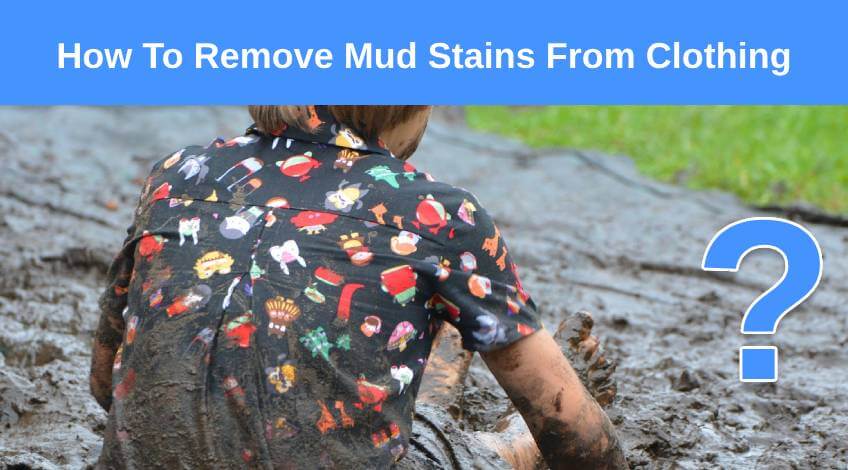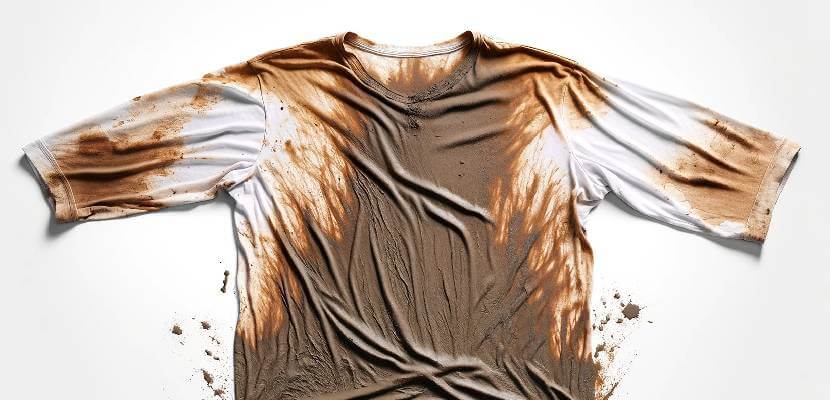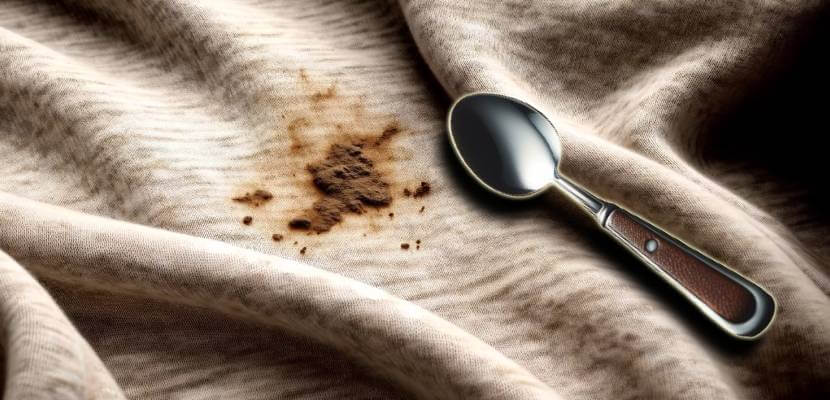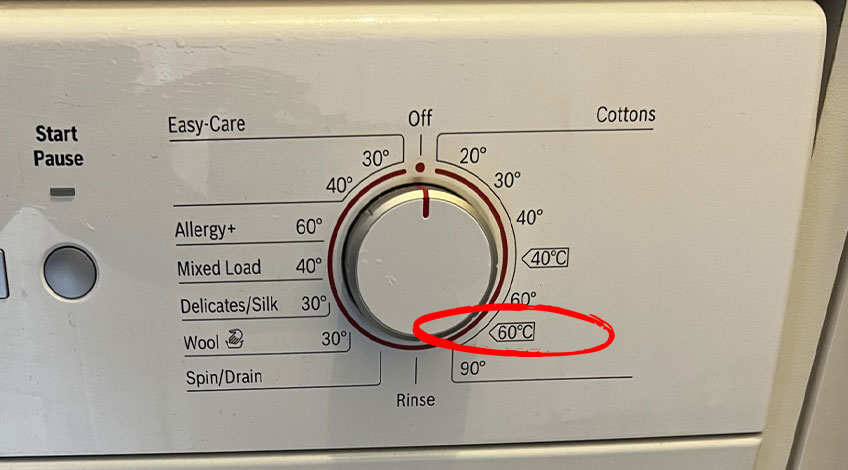
How To Remove Mud Stains From Clothing
Mud stains on clothes can be a frustrating and common problem, especially for people who enjoy outdoor activities, have children, or have dogs that get their paws everywhere. However, with the right approach and products, these pesky stains can be easily removed.
We find that letting the mud dry first and then pre-treating the stain are the most effective ways, which we’ll be talking about in this article, along with important tips to make your next laundry session a walk in the park.
Let’s get started!
Effective Ways To Remove Mud Stains From Your Clothes
Mud stains are a mix of soil, various minerals, and water. In an extremely unlucky situation, the mud may even contain animal faeces!
Due to their physical properties, mud stains can cling quite strongly to fibres, especially when they get dry. Because of this, it’s important to deal with it quickly for an easier removal process.
Before everything, you should remember:
- Let the mud dry before doing any pre-treatment.
- Read the care label of your garment to know how to wash and dry it properly and prevent damage.
Simple Guide For Removing Mud Stains On Different Fabric Types
To make the stain-removing process easier, feel free to refer to this table to prevent damage to your clothing:
| Fabric Type | Special Considerations | Recommended Cleaning Agents |
|---|---|---|
| Cotton and Linen | Durable, can withstand pre-treatment and scrubbing. | Stain remover or heavy-duty laundry detergent. |
| Synthetic Fabrics | Be gentle to avoid damaging the surface (e.g., Polyester, Nylon). | Mild detergent. |
| Delicate Fabrics | Avoid vigorous scrubbing or hot water (e.g., Silk, Wool). | Detergent designed for delicates. |
| Coloured and Dyed Fabrics | Test stain removal solution on an inconspicuous area first. | Avoid bleach unless sure the fabric can handle it. |
Here’s what you can do to make your clothes mud-stain-free again:
Allow The Mud To Dry
We get it – having mud stains on your favourite clothing can set you in a panic. However, resist the urge to immediately start scrubbing the mud off!
Why? Because wet mud is more likely to spread and cling deeper into the fibres of your clothing. It’s always best to let the mud dry completely, as it will become easier to remove once it’s no longer wet.

Depending on how huge the stain is, this may take a few hours or overnight, especially if the mud is thick. Patience is key!
Brush The Dried Mud Off
Once the mud is dry, you can now start working on removing the excess that’s hardened on your clothing. You can do this using the edge of a spoon or a butter knife.

Then, brush it off using a soft-bristled brush. You can also use a clean piece of cloth to lightly scrub the area.
Be careful not to be too harsh as this can damage your fabric. Removing the dried mud highly reduces the amount of residue that you will need to remove in the next steps, which will make your job easier.
Pre-Treat the Stain
Now that all the excess mud has been removed from your garment, it’s time to pre-treat the stain.
This is a very important step as you wouldn’t want to wash your clothing multiple times just to remove the mud stain, as it would be a waste of resources.
Depending on your preference, you can choose between commercial stain removers or household products for pre-treating stubborn mud marks.
Using Shop-Bought Stain Removers
There are various commercial stain removers available that are formulated to tackle tough stains like mud.
When it comes to mud, it’s best to choose stain removers that are enzyme-based, as it will allow easier removal.
As always, follow the instructions on the product! Most stain removers have to be applied directly on the stain and then left to sit for at least 30 minutes. Once the stain is completely removed, you can wash the fabric as normal.
- Fast acting multi purpose stain remover
- Removes a wide variety of stains
Using Laundry Detergent
If you prefer not to use a specialised stain remover, the laundry detergent you’re using can be used for pre-treatment, too.
Lay the clothing on a flat surface, making sure that you can easily access the stain.
If you’re using liquid detergent, directly apply it to the mud stain, rub gently, and let it sit for 30 minutes before washing.
If you’re using powdered detergent, make a paste by adding a bit of water, then apply directly to the stain. Rub gently, and allow the paste to sit for at least 30 minutes. Wash as normal.
Using Bleach On White Clothing
If the stained garment is white and bleach-safe, you can use a diluted bleach solution.
Test the diluted bleach on a small, inconspicuous area first. Once you’re sure that it won’t stain, follow the instructions on the bleach bottle, especially on how long you can let the solution sit on your fabric.
WARNING: Chlorine bleach should never be used on coloured fabrics! Pre-treat by making oxygen bleach as a paste if you want a tough alternative.
SEE ALSO: Bleach Vs Oxygen Bleach (what’s the difference & when to use them)
Using Bicarbonate Of Soda
Do you want to remove the mud stain on your clothing, but use as few chemicals as possible? If you have sensitive skin or want an environmentally friendly approach, bicarbonate of soda is a cheap and effective solution.
Bicarbonate of soda is known for its cleaning and deodorising properties and can be quite effective on mud stains.

Just make a paste by mixing a bit of water with bicarbonate of soda, then apply it directly on the stain. Leave it for at least an hour, then wash it as normal.
TIP: Bicarbonate of soda is gentle enough to leave on fabrics overnight. If the mud stain is tough, you can apply the paste and wash it off the next morning. It is also great for removing odours if the stain has a foul smell.
Using Rubbing Alcohol Or Hand Sanitiser
Yes, rubbing alcohol and hand sanitiser are products you can use for pre-treating mud stains. Their properties break down the mud’s composition, which reduces its clinging to the fabric.
Before using, test the alcohol or hand sanitiser on an inconspicuous part of your garment. Then apply a small amount of the solution to the stain and gently rub it in with a clean cloth.
Wash The Fabric
Now that you’re done with pre-treating the stain, it’s finally time to wash your garment!
Wash the garment as you normally would, making sure to follow the instructions on the care label. We recommend using the warmest temperature that your fabric allows, as it will also disinfect your clothing after being exposed to mud.

TIP: It’s best to wash your clothing once all the stain is removed, or else you may be setting it and making it more difficult to bring back to its former glory.
Dry The Fabric Outdoors
If possible, dry the garment outdoors in the sun! The sun’s natural bleaching effect can help remove any residual stain.
However, make sure that the fabric is suitable for sun drying as some materials can fade or weaken in direct sunlight.
For coloured garments that have a high potential to fade, air drying is enough. Avoid using the dryer as it can make the stain permanent!
SEE ALSO: Air Drying Vs Tumble Drying Clothes: which is better?
Removing Mud Stains From Leather Garments
Leather is durable, but can be very sensitive! Hence, if it’s stained with mud, it may require special care.
Here’s what to do:
- Resist the urge to wipe fresh mud off leather. Let it dry completely, as wet mud can spread and seep deeper into the leather.
- Once dry, use a soft-bristled brush to gently remove the mud. Brush in one direction to avoid damaging the leather’s surface.
- Prepare a mild solution of warm water and gentle soap. Dip a soft cloth into the solution, wring it out, and carefully dab the stained area. Avoid soaking the leather.
- With a separate damp cloth, wipe off the soap solution. Then, use a dry towel to pat the area dry. Never use heat or direct sunlight to dry leather.
- After the leather is completely dry, apply a leather conditioner. This step is crucial to maintain the suppleness and prevent cracking.
Can You Remove Mud Stains On Dry-Clean Only Clothes?
If you’re dealing with a particularly stubborn stain, or a delicate fabric, or are nervous that you’ll mess up the process, it’s wise to seek professional help.
Dry cleaning professionals have specialised techniques and products that can effectively remove tough stains without damaging the fabric.
Say Goodbye to Mud Stains!
Mud stains don’t have to mean the end of your favourite outfit. With the right techniques, a bit of patience, and gentle handling, you can successfully tackle these stains and keep your clothes looking their best.
Remember, when in doubt, particularly with delicate or expensive items, professional cleaning is often the safest option!
Do you have questions? Feel free to leave a comment below!
Frequently Asked Questions
Mud stains are not particularly hard to remove if you follow the right steps. Letting the mud dry, brushing off the excess, and then pre-treating the stain before washing are effective ways to tackle mud stains.
The best stain remover for mud is typically an enzyme-based commercial stain remover. These are formulated to break down the components of mud stains effectively. Alternatively, a household item like bicarbonate of soda can also be effective.
You should wash mud stains in the warmest water temperature safe for the fabric, as indicated by the garment’s care label. Warm water helps in effectively removing the mud and disinfecting the clothing.
Vinegar might help remove mud stains due to its acidic nature, which can break down the dirt. However, it’s not as commonly recommended as enzyme-based stain removers or detergents. If using vinegar, test it on a small area first to ensure it doesn’t damage the fabric.
To get old mud stains out of clothes, you’ll need to rehydrate the stain first and then follow a similar process to fresh stains: pre-treat with a stain remover or a detergent paste, gently scrub, and then wash in the warmest water appropriate for the fabric.





